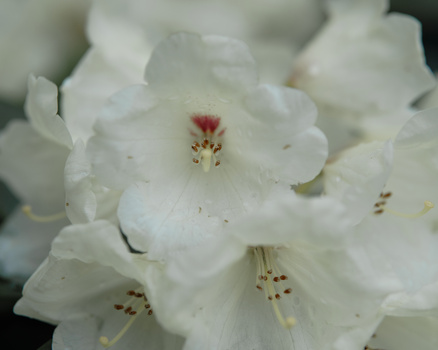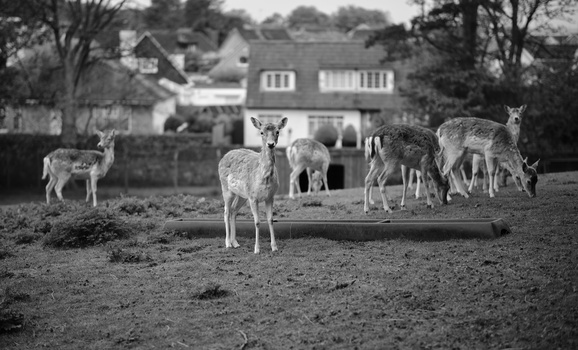The Sigma 56mm f/1.4 DC DN Contemporary lens for Fujifilm was first released in 2022 and added to their growing line of X Mount prime lenses, which also includes the 16mm and 30mm. This trio of contemporary lenses is designed to be compact while delivering high-quality results at an affordable price. While these lenses offer slightly less features than the Art series of lenses, making them more affordable to a wider audience, the image quality is not compromised in any way, and these relatively inexpensive prime lenses make them a compelling option to explore.
This is the second Sigma lens I've had the opportunity to test out and for the four weeks, I never removed it from the Fuji X-T5, opting simply to see if it performed well in every situation it was presented with. It was great in low light thanks to the f/1.4 aperture and even in bright sunlight, it didn't suffer from lens flare.
Build Quality
The lens is lightweight at only 280 g, which provides a good balance when mounted on the X-T5. It's durable and of solid polycarbonate construction measuring 59.5 x 66.5 mm in length and diameter respectively, with a filter thread size of 55 mm. There's also a rubber seal at the mount, making it dust- and splash-proof.  There are 10 elements in 6 groups with a minimum aperture of f/1.4 and a maximum of f/16 with 9 diaphragm blades. The glass is super multilayer coated to suppress flares and ghosting in order to achieve more contrast and color accuracy. The manual focus ring provides good friction, allowing for precise focusing. The stepping motor is silent and provides fast and accurate autofocus, which can be used in conjunction with eye detection for both stills and video work. The minimum focusing distance for the lens is 50 cm, which I discovered quickly due to being too close for some subjects. This is not a negative, however, as the images at this distance return a clear, sharp rendering with a magnification ratio of 1:7.4.
There are 10 elements in 6 groups with a minimum aperture of f/1.4 and a maximum of f/16 with 9 diaphragm blades. The glass is super multilayer coated to suppress flares and ghosting in order to achieve more contrast and color accuracy. The manual focus ring provides good friction, allowing for precise focusing. The stepping motor is silent and provides fast and accurate autofocus, which can be used in conjunction with eye detection for both stills and video work. The minimum focusing distance for the lens is 50 cm, which I discovered quickly due to being too close for some subjects. This is not a negative, however, as the images at this distance return a clear, sharp rendering with a magnification ratio of 1:7.4.  Again, like the other lenses in the Sigma range, there is no aperture ring on the lens itself, so your apertures are controlled by the command dial of your camera. Personally, I prefer the aperture ring, but you very quickly get used to going back to the command dial, so this is no biggie considering the performance you get from the lens.
Again, like the other lenses in the Sigma range, there is no aperture ring on the lens itself, so your apertures are controlled by the command dial of your camera. Personally, I prefer the aperture ring, but you very quickly get used to going back to the command dial, so this is no biggie considering the performance you get from the lens.
The lens is accompanied by the usual front and end caps and plastic lens hood, which seems very durable and doesn't add any considerable length to the lens, keeping it quite discreet for street photography.
Performance
So, with a very decent build quality, how does the lens perform? Instead of dedicating the lens to portraits, which it would be perfect for with a 35mm full frame equivalent of 84mm, I simply used the lens as an everyday carry lens for the time I had it. Peter Coco includes some portraiture images in his review of the lens, which can be found here.
With the camera set to aperture priority, I photographed a variety of locations to see how the lens performed in this manner and was really pleased with the detail captured. As expected, at f/1.4, the depth of field is very narrow and produces a buttery softness surrounding the focus point.
The bokeh of the lens is also very admirable and could provide very effective backgrounds in natural light portraits or street scenes.
There is a slight vignetting at the wider apertures, which is to be expected, and this clears by the time you reach f/4. Incidentally, if you shoot JPEG, the in-camera corrections remove this completely at f/2.8. The image below shows the in-camera correction at f/2, which although still there, is very subtle. I found the sweet spot of the lens to be between f/5.6 and f/8, so I spent the majority of the time shooting there. Even at the smaller apertures, the lens performed admirably.
I found the sweet spot of the lens to be between f/5.6 and f/8, so I spent the majority of the time shooting there. Even at the smaller apertures, the lens performed admirably.
The lens produces sharp images, and when you zoom in 100%, the detail captured is clear to see. Even shooting over distance, I was enamored by how the lens utilized the 40 megapixels of the Fuji X-T5 to its advantage in retaining detail. The video below shows the corners of the image when photographed at f/5.
Overall, the lens returned a series of sharp images no matter the aperture,and even when zoomed into 100%, the details are apparent.
The gallery images below are a mix of raw files and camera JPEG to allow you to see the quality of the images the lens produces.
What I Liked
The lens is a great combination with, in this case, the X-T5 as it's lightweight, compact, and sharp. It's dust- and splash-resistant and has a maximum aperture of f/1.4.
What I Didn't Like
No dedicated aperture ring, which is just a personal preference, and doesn't affect the lens performance in any way at all. No OIS, but again, due to the compact size and weight of the lens your camera IBIS will take care of this.
Final Thoughts
When it comes to the glass that utilizes the image sensor, third-party lenses for any camera manufacturer can be a hit or miss. Some work great, while others just miss the mark. This is now the second Sigma lens for the Fuji X mount I've had the opportunity to test. The first one was the Sigma 18-50mm f/2.8 DC DN Contemporary Lens, which incidentally, I purchased just a couple of weeks ago because of how well it performed. If you're interested, you can find a review of that lens here.
Sigma has done it again with this lens, as I found nothing that would put me off considering it for my kit bag. It produces rich, sharp images, has great autofocus, and is lightweight and compact. Although relatively low in cost, the lens feels and performs like a premium lens and would be a worthy addition to your own kit bag for portrait, travel, pet, street, and everyday photography.
I would certainly consider this lens if you are in the market for a similar focal range, as it won't disappoint. You can find out more about the lens and where to purchase here.
Coincidently, at the time of writing this article, B&H has a discount on the lens, and it is retailing at $404, saving you $75. This may be over by the time you read the article, but it would be worth keeping an eye out in case the savings appear again.





































